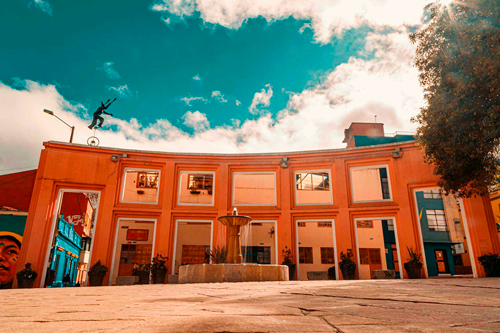
Faenza Theater
The Faenza Theater, symbol of the recovery of Bogotá's architectural heritage, is considered an asset of national cultural interest. It is the oldest film screening theater in the city, with the film "L'ironie du destin" by Dimitri Kirsanoff. It stands out for preserving samples of grotesque painting, being the only non-religious construction in Colombia with this style. In addition, its decoration includes relief works, moldings and plaster foliage, while its lamps are authentic pieces of art made by hand with various artisanal techniques.
Cultural Square La Santamaría
It was built in 1931 as a bullring with a capacity for 14,500 visitors. The current facade was designed by the Spanish architect Santiago de la Mora, and it is characterized by brick walls in the neo-Mudéjar style. It is currently a center of art and culture, where artists perform and sports tournaments take place. The sand has even been used to set up a children's beach. It is a cultural icon and was declared a National Monument in 1984.
Simón Bolívar Park
In Bogotá you will enjoy unique outdoor settings; You will reconnect with nature and experience unique sensations with aromas and sounds of the endemic vegetation of the capital.
In Bogotá you will enjoy unique outdoor settings; You will reconnect with nature and experience unique sensations with aromas and sounds of the endemic vegetation of the capital.
Los Mártires
In honor of the martyrs who lost their lives in the struggles for independence, this is how Bogotá's 14th town was named. Located in the center of the capital, the town exhibits an important historical and cultural legacy through ancient religious temples, heritage buildings and settings such as the Renaissance Park.
La Independencia-Bicentenario Park
Located on the eastern side of the town of Santa Fe, in the foothills of the eastern hills that border Bogotá, is the historic Parque de La Independencia, one of the oldest in the city and home to several works declared historical and cultural heritage. It was built in 1910 to commemorate the first centennial of Colombia's Independence on July 20, 1810.
Santa Fe
Santa Fe is town number three in the Capital District of Bogotá. It forms the traditional center of the city, sharing it with La Candelaria, a town that is located in its territory, separated in 1991. The town Santa Fe derived its name from the old name of the capital. Much of the colonial and early 20th century Bogotá is located in this town.
La Candelaria
La Candelaria is in the eastern center of Bogotá. In the historic center where the city was founded on August 6, 1538. It is a vibrant place with places such as the Plaza de Bolívar and the Catedral Primada de Colombia. It is an important tourist center, educational and commercial.You'll find narrow streets lined with shops selling emeralds and handicrafts, leading to cultural landmarks such as the Museo del Oro with its pre-Columbian artifacts and the Museo Botero, which exhibits international art in a colonial mansion.
Eastern Hills
The Eastern Hills of Bogotá protect the city, shape the eastern mountain range of Colombia and represent the biodiverse wealth of the country in the city.
This chain of mountains extend from south to north and are part of towns such as Usme, San Cristóbal, Santa Fe, Chapinero and Usaquén; and today, they are considered protected areas for the country.
Teusaquillo
Teusaquillo is in the West Center of the city, northwest of the historic center. It is a completely urbanized locality with many green areas such as the Simón Bolívar park and the National University.
Teusaquillo has one of the largest and most beloved green spaces in the city, the Simón Bolívar Metropolitan Park, with trails around a lake with boats.
Other popular strolling spots nearby include the Botanical Garden of Bogotá, with gardens arranged by ecosystems, and the Parque de los Novios with its duck pond and a large playground for children.